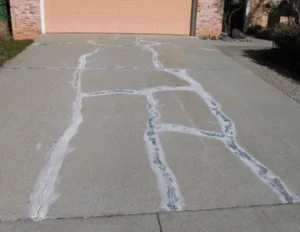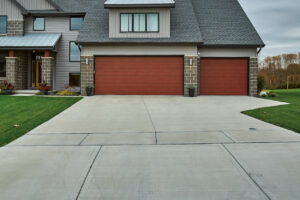Heavy traffic, climate changes, and normal wear and tear can take their toll on your driveway. Some problems are easy to repair, but others require a professional like Paving Companies Charleston SC.
Most cracks less than a quarter inch are easily repaired by professionals with cold-patch asphalt. But if your driveway is heaving or has major cracks, it’s best to replace it entirely.

Cracks are the most common problem with driveways. They can range from hairline cracks that do not connect to a wider section of the driveway that is sagging and sinking. These cracks must be repaired from normal wear and tear or concrete shrinkage after pouring to prevent further damage to the driveway surface.
Small cracks that do not connect are easy to repair with putty, filler, or sealant. These cracks are typically less than a quarter of an inch wide and should be filled before they worsen. For cracked sections that have sunk lower than the surrounding driveway surface, injecting a lifting foam is an effective solution that can be completed in a day.
A flexible filler or concrete patch is recommended for cracked driveway areas larger than a quarter of an inch. The material should shift slightly with temperature changes, allowing the crack to expand and contract without pulling away from the concrete surface. Cracks sagging, wagging, or going in and out of place may require additional fortification, such as foam backer rods.
Many large cracks result from heaving and movement of the earth under the driveway. These are more difficult to repair and may require replacement of the entire driveway surface.
Before applying any crack filler, weeds and debris should be removed before using any crack filler, and the area should be cleaned with a pressure washer or spray hose. For 1/2-inch or wider cracks, it is a good idea to insert foam backer rods into the crack before applying the filler or sealant. Following the manufacturer’s application instructions is important for the best results when using asphalt-based crack fillers. Typically, a thick bead of the crack filler should be placed along the entire width of the crack and then squeezed down to create an even appearance. If desired, the cracks can be sanded with an orbital sander fitted with coarse-grit sandpaper to smooth the surface. Resolving the driveway after any repairs are made is also a good idea.
If a section of your driveway has sunken down to the point of creating an obstruction or safety hazard, you may have to dig up and replace the old surface and sub-base to offer long-lasting stability. This can be an extensive and costly project that will require professional excavation services. However, you can do a few things to prevent future sinking and minimize the time and expense involved in this type of repair.
Begin by clearing the area of any weeds, grass, or other plants that have grown in and around your sunken sections. Use a shovel to carefully remove these growths, taking care not to dig deeper into the ground than necessary. Also, look for any large debris or stones contributing to the problem and remove them if possible.
Once the affected areas are clear, you can compact the soil. This is an important step in repairing sunken driveways, as it will provide the necessary support and prevent further sinking. Use a shovel to break up the soil, then use a tamper or hand roller to compact it. Continue this process until the ground feels firm and does not give way when walked on.
After compaction, add a layer of gravel to the affected areas. This will help protect the newly repaired surfaces from further damage, and it will also help reduce water accumulation that can contribute to future sinking.
Finally, apply a concrete patch to the damaged areas of your driveway. This will fill in the gaps and level the surface of your driveway, ensuring it is safe for driving and parking. When applying the patch, follow the manufacturer’s instructions for mixing and curing.
If you plan to perform these repairs yourself, wearing protective gear and covering your tools is a good idea to minimize the risk of injury or contamination. Having someone supervise the repair process is also a good idea, especially if you need to become more familiar with the equipment and materials required for the job. Additionally, you should consult a professional contractor who can provide guidance and expertise to ensure high-quality, long-lasting repairs.
Your driveway endures much stress from vehicles driving over it, cars sitting overnight, and other activities. This stress can destabilize the gravel fill and cause cracking in the asphalt. Small cracks can often be repaired with a concrete repair kit, but large ones must be filled and patched to prevent water seepage.
While cracks are important to repair, it’s equally important to ensure the edges of your driveway are well-dressed to avoid problems in the future. This can be done by grading the asphalt. This process involves creating a 45-degree angle around the perimeter of the driveway, which transfers stresses from the asphalt to the soil underneath, avoiding any damage to the pavement or edge material.
Rough or unfinished edges can also create a trip hazard and a barrier that makes maneuvering vehicles, trailers, or other equipment across the driveway difficult. Dressing the edge of your driveway with landscape materials or hard rock will prevent grass or weeds from encroaching on the asphalt. If you’re having your driveway repaved, talk to your contractor about including this step in the job. An honest, reputable contractor will happily address this issue with you during installation. A less scrupulous contractor will be more likely to leave the edges of your driveway uncovered and sloping, increasing the likelihood that they’ll need to be repaired later.
Once you’ve graded your driveway’s edges, you can refinish them with landscape material. This will help prevent weeds and grass from growing into the asphalt and add a finished look to keep your pavement looking great. Landscape rocks are the best option, as they’re hard and will transition well from the asphalt while adding stability and strength.
Once the landscaping has been installed, it’s important to maintain a regular maintenance routine to keep it looking its best. Sweep away debris, inspect the edges for shifting or damage, and seek professional long-term care and maintenance guidance to keep your newly refinished edged driveway looking its best!
A driveway is an important feature of your home. It protects your car from the elements and adds curb appeal to your property. Driveways are usually constructed from concrete or asphalt, although gravel and cobblestone paving are popular options. If your driveway is aging and showing damage, consider repair or replacement.
Cracks, pits, and fissures are typical signs of a damaged driveway. These are caused by general wear and tear and the impact of cars on the surfacing material. If these cracks aren’t wide or deep, patching them can be a cost-effective solution to the problem.
If your driveway has sunken sections or is heaving, it’s time to think about replacement. This damage typically occurs when the foundation under the surfacing is faulty. A heaved or sunken driveway can allow water to seep into the soil, which can cause irreversible damage to your home’s foundation. A professional can assess the situation and recommend a solution.
Resurfacing is the best option if you want your driveway to look brand new. It costs less than a full replacement and will last for several years.
Repairing and resurfacing are great ways to extend the life of your driveway, but eventually, it will need to be replaced. To avoid costly repairs in the future, you should schedule routine maintenance. This includes removing any weeds or plants that grow in the driveway. It’s also a good idea to patch cracks and fill in potholes as soon as they appear.
If you’re considering repairing or replacing your driveway, ensure you understand the damage’s extent and how long you’d like to keep it in service. With proper care, your driveway can last a couple of decades. Work with a reputable paving contractor to address any damage or concerns as early as possible for the best results.

